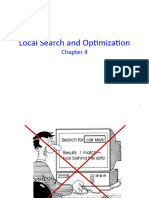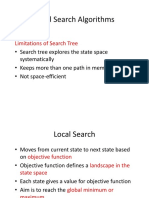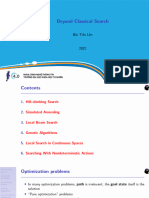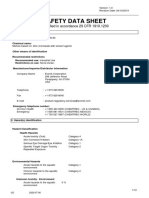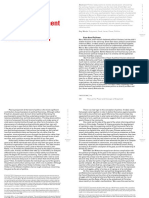Lecture 4: Local Search and Optimization
CPEN 405: Artificial Intelligence
Instructor: Robert A. Sowah, PhD
Outline
• Local search techniques and optimization
– Hill-climbing
– Gradient methods
– Simulated annealing
– Genetic algorithms
– Issues with local search
Local search and optimization
• Previously: systematic exploration of search space.
– Path to goal is solution to problem
• YET, for some problems path is irrelevant.
– E.g 8-queens
• Different algorithms can be used
– Local search
Local search and optimization
• Local search
– Keep track of single current state
– Move only to neighboring states
– Ignore paths
• Advantages:
– Use very little memory
– Can often find reasonable solutions in large or infinite (continuous)
state spaces.
• “Pure optimization” problems
– All states have an objective function
– Goal is to find state with max (or min) objective value
– Does not quite fit into path-cost/goal-state formulation
– Local search can do quite well on these problems.
“Landscape” of search
Hill-climbing search
function HILL-CLIMBING( problem) return a state that is a local maximum
input: problem, a problem
local variables: current, a node.
neighbor, a node.
current MAKE-NODE(INITIAL-STATE[problem])
loop do
neighbor a highest valued successor of current
if VALUE [neighbor] ≤ VALUE[current] then return STATE[current]
current neighbor
Hill-climbing search
• “a loop that continuously moves in the direction of increasing value”
– terminates when a peak is reached
– Aka greedy local search
• Value can be either
– Objective function value
– Heuristic function value (minimized)
• Hill climbing does not look ahead of the immediate neighbors of the
current state.
• Can randomly choose among the set of best successors, if multiple
have the best value
• Characterized as “trying to find the top of Mount Everest while in a
thick fog”
Hill climbing and local maxima
• When local maxima exist, hill climbing is suboptimal
• Simple (often effective) solution
– Multiple random restarts
Hill-climbing example
• 8-queens problem, complete-state formulation
– All 8 queens on the board in some configuration
• Successor function:
– move a single queen to another square in the same column.
• Example of a heuristic function h(n):
– the number of pairs of queens that are attacking each other
(directly or indirectly)
– (so we want to minimize this)
Hill-climbing example
Current state: h=17
Shown is the h-value for each possible successor in each column
A local minimum for 8-queens
A local minimum in the 8-queens state space (h=1)
Other drawbacks
• Ridge = sequence of local maxima difficult for greedy algorithms to
navigate
• Plateau = an area of the state space where the evaluation function is
flat.
Performance of hill-climbing on 8-queens
• Randomly generated 8-queens starting states…
• 14% the time it solves the problem
• 86% of the time it get stuck at a local minimum
• However…
– Takes only 4 steps on average when it succeeds
– And 3 on average when it gets stuck
– (for a state space with ~17 million states)
Possible solution…sideways moves
• If no downhill (uphill) moves, allow sideways moves in hope
that algorithm can escape
– Need to place a limit on the possible number of sideways moves to
avoid infinite loops
• For 8-queens
– Now allow sideways moves with a limit of 100
– Raises percentage of problem instances solved from 14 to 94%
– However….
• 21 steps for every successful solution
• 64 for each failure
Hill-climbing variations
• Stochastic hill-climbing
– Random selection among the uphill moves.
– The selection probability can vary with the steepness of the uphill
move.
• First-choice hill-climbing
– stochastic hill climbing by generating successors randomly until a
better one is found
– Useful when there are a very large number of successors
• Random-restart hill-climbing
– Tries to avoid getting stuck in local maxima .
Hill-climbing with random restarts
• Different variations
– For each restart: run until termination v. run for a fixed time
– Run a fixed number of restarts or run indefinitely
• Analysis
– Say each search has probability p of success
• E.g., for 8-queens, p = 0.14 with no sideways moves
– Expected number of restarts?
– Expected number of steps taken?
Local beam search
• Keep track of k states instead of one
– Initially: k randomly selected states
– Next: determine all successors of k states
– If any of successors is goal finished
– Else select k best from successors and repeat.
• Major difference with random-restart search
– Information is shared among k search threads.
• Can suffer from lack of diversity.
– Stochastic beam search
• choose k successors proportional to state quality.
Gradient Descent
Assume we have some cost-function: C (x1,..., xn )
and we want minimize over continuous variables X1,X2,..,Xn
1. Compute the gradient : C (x1,..., xn ) i
xi
2. Take a small step downhill in the direction of the gradient:
xi x 'i xi C (x1,..., xn ) i
xi
3. Check if C (x1,.., x 'i ,.., xn ) C (x1,.., xi ,.., xn )
4. If true then accept move, if not reject.
5. Repeat.
Learning as optimization
• Many machine learning problems can be cast as optimization
• Example:
– Training data D = {(x1,c1),………(xn, cn)}
where xi = feature or attribute vector
and ci = class label (say binary-valued)
– We have a model (a function or classifier) that maps from x to c
e.g., sign( w. x’ ) {-1, +1}
– We can measure the error E(w) for any settig of the weights w, and
given a training data set D
– Optimization problem: find the weight vector that minimizes E(w)
(general idea is “empirical error minimization”)
Learning a minimum error decision boundary
Minimum Error
7 Decision Boundary
5
FEATURE 2
0
0 1 2 3 4 5 6 7 8
FEATURE 1
Search using Simulated Annealing
• Simulated Annealing = hill-climbing with non-deterministic search
• Basic ideas:
– like hill-climbing identify the quality of the local improvements
– instead of picking the best move, pick one randomly
– say the change in objective function is
– if is positive, then move to that state
– otherwise:
• move to this state with probability proportional to
• thus: worse moves (very large negative ) are executed less
often
– however, there is always a chance of escaping from local maxima
– over time, make it less likely to accept locally bad moves
– (Can also make the size of the move random as well, i.e., allow
“large” steps in state space)
Physical Interpretation of Simulated Annealing
• A Physical Analogy:
• imagine letting a ball roll downhill on the function surface
– this is like hill-climbing (for minimization)
• now imagine shaking the surface, while the ball rolls, gradually
reducing the amount of shaking
– this is like simulated annealing
• Annealing = physical process of cooling a liquid or metal until
particles achieve a certain frozen crystal state
• simulated annealing:
– free variables are like particles
– seek “low energy” (high quality) configuration
– get this by slowly reducing temperature T, which particles
move around randomly
Simulated annealing
function SIMULATED-ANNEALING( problem, schedule) return a solution state
input: problem, a problem
schedule, a mapping from time to temperature
local variables: current, a node.
next, a node.
T, a “temperature” controlling the probability of downward
steps
current MAKE-NODE(INITIAL-STATE[problem])
for t 1 to ∞ do
T schedule[t]
if T = 0 then return current
next a randomly selected successor of current
∆E VALUE[next] - VALUE[current]
if ∆E > 0 then current next
else current next only with probability e∆E /T
More Details on Simulated Annealing
– Lets say there are 3 moves available, with changes in the objective
function of d1 = -0.1, d2 = 0.5, d3 = -5. (Let T = 1).
– pick a move randomly:
• if d2 is picked, move there.
• if d1 or d3 are picked, probability of move = exp(d/T)
• move 1: prob1 = exp(-0.1) = 0.9,
– i.e., 90% of the time we will accept this move
• move 3: prob3 = exp(-5) = 0.05
– i.e., 5% of the time we will accept this move
– T = “temperature” parameter
• high T => probability of “locally bad” move is higher
• low T => probability of “locally bad” move is lower
• typically, T is decreased as the algorithm runs longer
– i.e., there is a “temperature schedule”
Simulated Annealing in Practice
– method proposed in 1983 by IBM researchers for solving VLSI
layout problems (Kirkpatrick et al, Science, 220:671-680, 1983).
• theoretically will always find the global optimum (the best
solution)
– useful for some problems, but can be very slow
– slowness comes about because T must be decreased very
gradually to retain optimality
• In practice how do we decide the rate at which to decrease T?
(this is a practical problem with this method)
Genetic algorithms
• Different approach to other search algorithms
– A successor state is generated by combining two parent states
• A state is represented as a string over a finite alphabet (e.g. binary)
– 8-queens
• State = position of 8 queens each in a column
=> 8 x log(8) bits = 24 bits (for binary representation)
• Start with k randomly generated states (population)
• Evaluation function (fitness function).
– Higher values for better states.
– Opposite to heuristic function, e.g., # non-attacking pairs in 8-queens
• Produce the next generation of states by “simulated evolution”
– Random selection
– Crossover
– Random mutation
–
–
Genetic algorithms
• Fitness function: number of non-attacking pairs of queens (min = 0, max = 8 ×
7/2 = 28)
• 24/(24+23+20+11) = 31%
• 23/(24+23+20+11) = 29% etc
•
•
•states for
4 2 pairs of 2 states randomly New states Random
8-queens selected based on fitness. after crossover mutation
problem Random crossover points applied
selected
Genetic algorithms
Has the effect of “jumping” to a completely different new
part of the search space (quite non-local)
Genetic algorithm pseudocode
function GENETIC_ALGORITHM( population, FITNESS-FN) return an individual
input: population, a set of individuals
FITNESS-FN, a function which determines the quality of the individual
repeat
new_population empty set
loop for i from 1 to SIZE(population) do
x RANDOM_SELECTION(population, FITNESS_FN)
y RANDOM_SELECTION(population, FITNESS_FN)
child REPRODUCE(x,y)
if (small random probability) then child MUTATE(child )
add child to new_population
population new_population
until some individual is fit enough or enough time has elapsed
return the best individual
Comments on genetic algorithms
• Positive points
– Random exploration can find solutions that local search can’t
• (via crossover primarily)
– Appealing connection to human evolution
• E.g., see related area of genetic programming
• Negative points
– Large number of “tunable” parameters
• Difficult to replicate performance from one problem to another
– Lack of good empirical studies comparing to simpler methods
– Useful on some (small?) set of problems but no convincing
evidence that GAs are better than hill-climbing w/random restarts
in general
Online search
• Online search problems
• Online search agents
• Online local search
• Learning in online search
Summary
• Local search techniques and optimization
– Hill-climbing
– Gradient methods
– Simulated annealing
– Genetic algorithms
– Issues with local search







